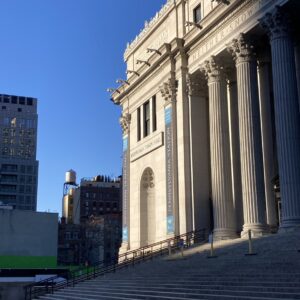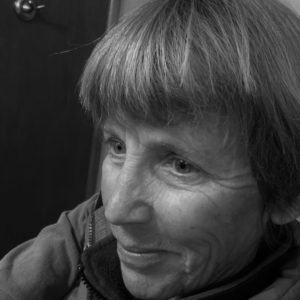 The story goes that my sister Julia, newly arrived at UC Santa Cruz, was sitting in class on the afternoon of October 17, 1989, when the ground began to tremble. The class was a large lecture class and Julia watched in amazement as dozens of her fellow PhD students jumped up from their seats and ran for the doorways. Believing it was nothing but the rumble of the subway, which being a New Yorker she was used to, she stayed put. It only crossed her mind a few minutes later that Santa Cruz had no subway but it did sit along the San Andreas Fault. Later she would learn that the town of Loma Prieta in the Santa Cruz Mountains, only a matter of miles from the seat she was sitting in, was the epicenter of a 6.9 earthquake that took the lives of 63 people.
The story goes that my sister Julia, newly arrived at UC Santa Cruz, was sitting in class on the afternoon of October 17, 1989, when the ground began to tremble. The class was a large lecture class and Julia watched in amazement as dozens of her fellow PhD students jumped up from their seats and ran for the doorways. Believing it was nothing but the rumble of the subway, which being a New Yorker she was used to, she stayed put. It only crossed her mind a few minutes later that Santa Cruz had no subway but it did sit along the San Andreas Fault. Later she would learn that the town of Loma Prieta in the Santa Cruz Mountains, only a matter of miles from the seat she was sitting in, was the epicenter of a 6.9 earthquake that took the lives of 63 people.
New Yorkers are stubborn, yes, and honestly, they don’t get out much. They wouldn’t deny the existence of earthquakes, but they’d always think of the subway first.
Julia and I grew up ten floors above the street along the IRT Lexington Avenue Line in Manhattan. Every time a train departed the 77th Street station, or the 68th at Hunter College, it was just gaining speed as it passed under our building. The building shook a little and we often heard the high screech of brakes as the train took a corner. The subway was like an underground animal, a mechanized serpent that hissed stale air through the gratings on the sidewalk. Its rumble was so familiar to us we didn’t hear it or feel it unless we left the city for a while and came back again.
My dad was a connoisseur of trains. He loved trains. He filmed them and staged a horror film around trains, a home movie in which three naughty children tie their mother to the railroad tracks and dance up and down with glee when she meets her demise. (I think I once wrote about my experience as one of those naughty children, and once was enough.) But Dad wasn’t a subway guy. The dark and gloom didn’t suit his temperament. He didn’t, as I do, find subways beautiful. I like the graffiti, the idea of a subway car as a giant canvas. I like the feeling of danger in the space between cars, and the sound of the doors whooshing open from stop to stop. I like the straps that hang from above, and when I was a kid my greatest aspiration was to be tall enough to grab an overhead strap. The strap swings a little, while the gleaming pole attracts those who prefer to feel safe and rooted. And the crowds! Oh, the horrifying and magnificent press of people and more people, strangers dashing together down iron tracks, each on their own mission, with their own destination. Kids with backpacks, accountants with briefcases, yogis with their mats on their backs, headed to class. Rush hour, when the coffee has kicked in, or the off hours when a figure wrapped in a coat or a blanket lies across two seats in search of rest. I love the notion that you can go great dark distances on one track, then erupt from below into daylight. The darkness shrinks the miles between the boarding and the disembarking, so arriving is almost an act of magic.
When I was growing up in New York City, the subway was much maligned and stank of pee and a thousand pheromones, and someone was always shrieking or playing the saxophone at high volume, but it was life and I liked it. I loved the tokens, heavier than real money in my pocket, and I feared the third rail that could kill you instantly. Every subway station was a cave, its tunnels leading off in all directions—to Yankee Stadium to watch the Giants, to Shea to watch the Mets, to Christopher Street, Chinatown, the World Trade Center. Points of notoriety, infamous and alluring. The Stonewall Inn could be reached by the 6, 7, and 2 trains. For the Statue of Liberty you took the Express 4 or 5. History was at my fingertips, thanks to the subway. The great looming icons of past and recent memory—the Empire State Building, the Apollo Theater, the Guggenheim squatting on Fifth Avenue like a fallen soufflé—the subway and your own two feet could take you there.
I don’t miss the life of the city, though our town has grown too fast to pretend it’s not a city of its own. I do miss the subway that ran like a life-giving artery through my childhood. It taught me the difference between caution and fear, and it promised me freedom. Sometimes, when I’m walking in a narrow canyon, I have the strange experience of looking up and feeling as I used to on the subway, the feeling of an entire city floating above me, unseen.

